Kara Walker: Words as Images
In a lecture in 1993, at Seminole Community College in Florida recorded on video, Adrian Piper presents, “Art Talk: Xenophobia and the Indexical Present,” which now lives on the artist’s website. She laments that, “Art is not just about craft, it’s not simply about being really skilled at rendering a face or rendering a landscape, it’s also about using the intellect as a creative tool. A lot of us were involved in a lot of different things; some people were doing number theory, some people were doing set theory and there were people who were interested in linguistics, physics, or mathematics. We were all investigating these different disciplines as ways of bringing to bear a different set of resources to the art we made.” In 1988, while attending the Atlanta College of Art, Kara Walker was introduced to Piper’s conceptual practice by an instructor.
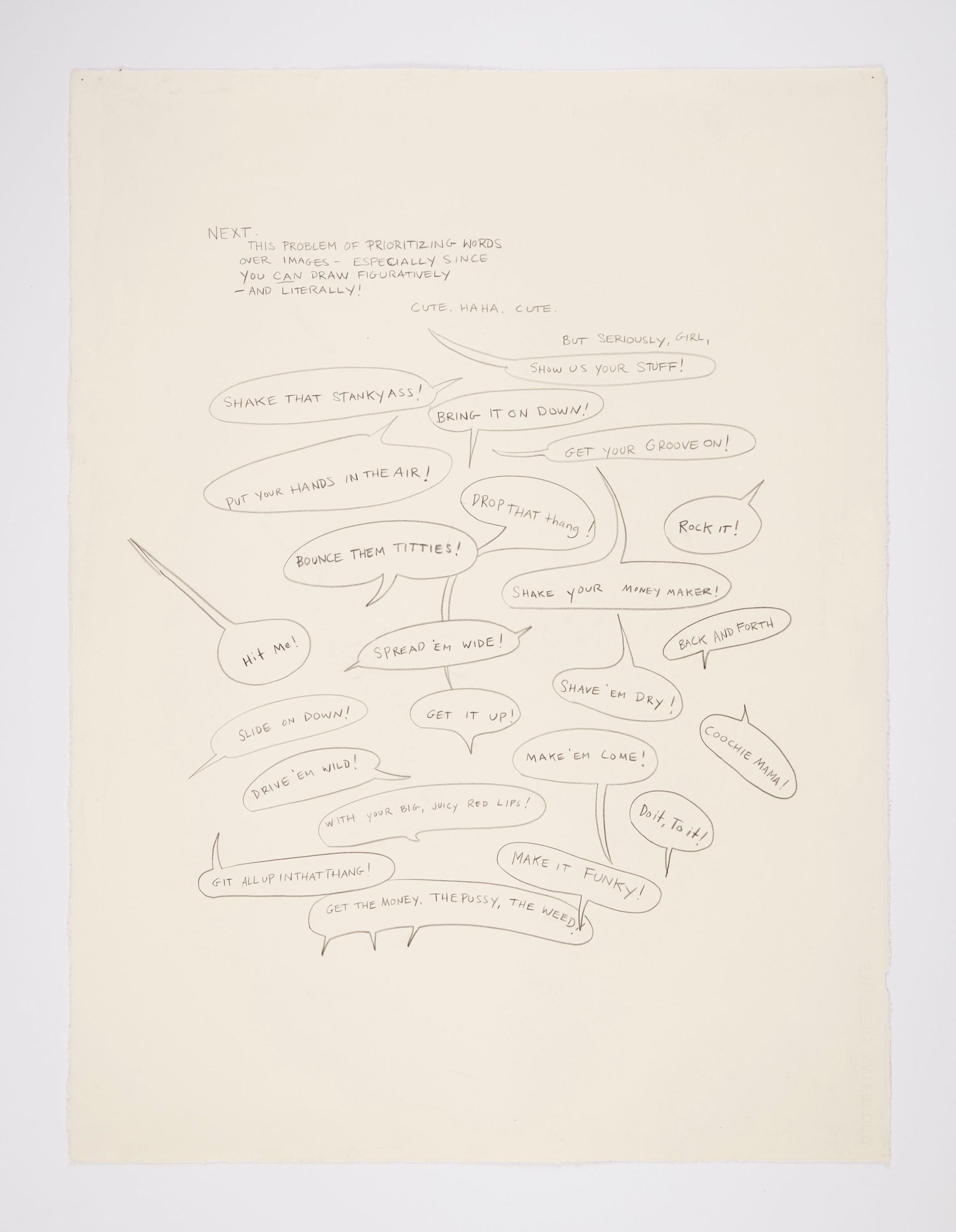

In turn, Walker wrote an essay titled, “Black/White (grey) notes on Adrian Piper,” and in 2007, when Walker recounts this experience on the eve of her show opening in Paris to Hilton Als, he writes, “The piece is a series of lyrical statements and questions that Walker asked herself: 'I’m not an Other in some eyes / I think / and yet a black woman-artist-philosopher has a / calling card to announce when she has been stumbled upon / injured, ignored by the elite / over whom she strives to soar.'” Walker was not only announcing her ambitions; as she makes clear in the next line—“Am I ignorant of all strife?”—she was pushing herself toward identity politics, and beginning to question her own existence between two worlds, as a relatively privileged black woman. Walker now says of the paper, “I think it reveals something of my inhibitions at the time about making any kind of racialized gesture in my work.” Back then, she said, her attitude toward race and art was “I’m not going to ghettoize. You have ‘real’ art, and then the art of the ethnic minority.”
Adrian Piper continues, in "Xenophobia and the Indexical Present," to describe a gridded sheet of paper from a sixty-four-page book, that announces through description the location of the square inside the very square that it is describing. She remarks, “This was my attempt to use language in a concrete way to refer to the indexical present, to refer to the here-and-now of this page of paper with no abstract topics; no things that essentially change the subject, but rather that refer to themselves.” She then speaks of her Hypothesis (1968-69) series, saying, “I was using language to refer to just itself and concrete objects…I was thinking of myself as a three dimensional object in a three dimensional world, and other objects in the world like paper, blocks of clay, or pieces of wood. The difference between me and those objects is that I could represent my own experience, my own consciousness in space and time, not only could I move through space and time, just as any sculptural object can do, but I could also represent that movement in my own consciousness.”

In Kara Walker’s practice writ large the work has always borne one truth: language. In Simulacra and Simulation, Jean Baudrillard writes in the chapter, The Precession of Simulacra and sub-chapter, The Divine Irreference of Images, “To dissimulate is to pretend not to have what one has. To simulate is to feign to have what one doesn’t have." One implies a presence, and the other an absence. But it is more complicated than that because simulating is not pretending: “Whoever fakes an illness can simply stay in bed and make everyone believe he is ill. Whoever simulates an illness produces in himself some of the symptoms.” (Littré).
Baudrillard continues, "Therefore, pretending, or dissimulating, leaves the principle of reality intact: the difference is always clear, it is simply masked, whereas simulation threatens the difference between the “true” and the “false,” the “real” and the “imaginary.” Is the simulator sick or not, given that he produces “true” symptoms? Objectively one cannot treat him as being either ill or not ill. Psychology and medicine stop at this point, forestalled by the illness’s henceforth and undiscoverable truth. For if any symptom can be “produced,” and can no longer be taken as a fact of nature, then every illness can be considered as simulatable and simulated, and medicine loses its meaning since it only knows how to treat “real” illnesses according to their objective causes.”
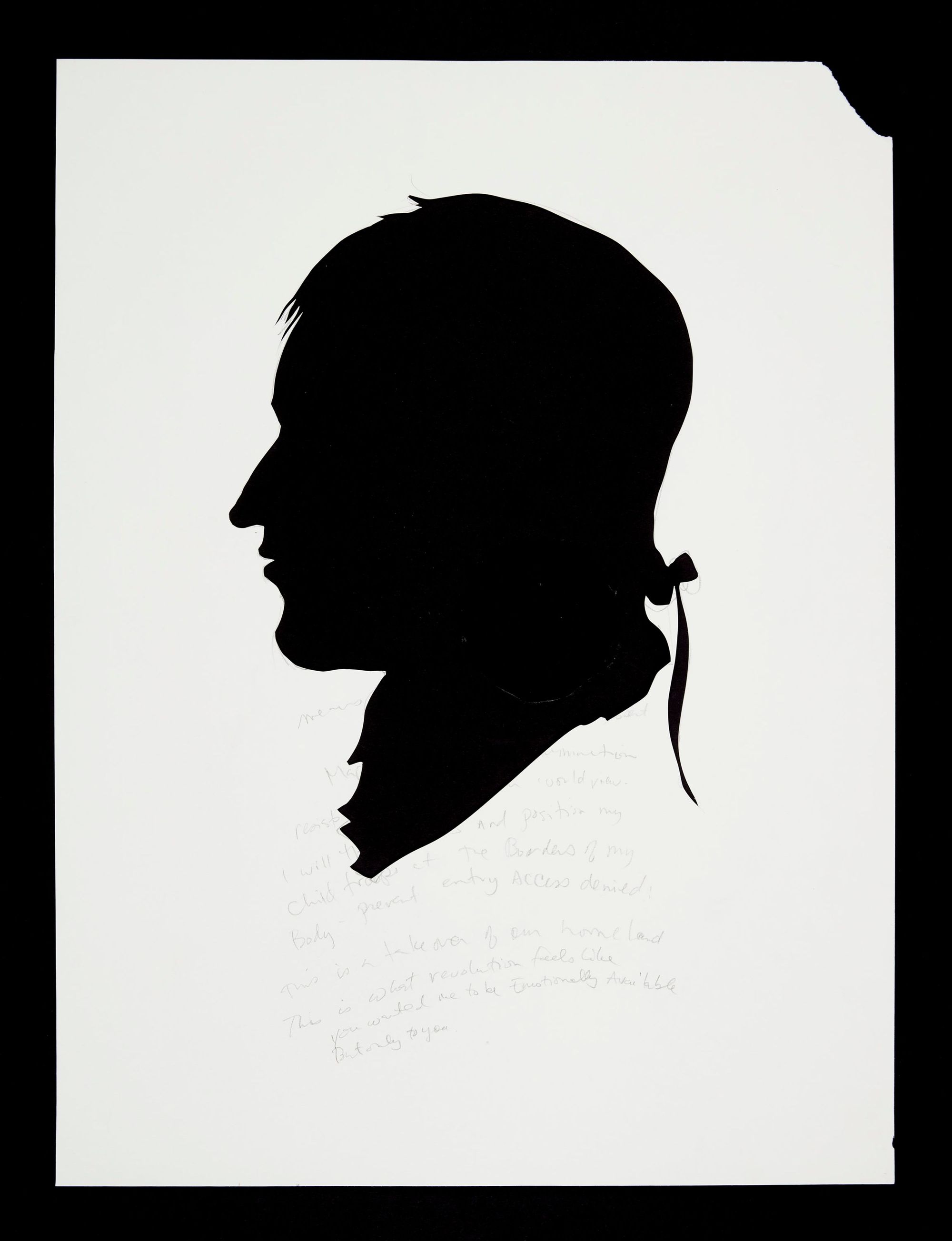
Last week, I found myself at Sikkema Jenkins wavering through the gallery engaging in “Drawings,” the most recent installment of Kara Walker’s work in New York. The show is concerned with what has been archived or what has fallen to the wayside, works that vary in size and declaration. "I AM NOT MY NEGRO" stains one wall. After being quarantined for months, to some extent, I’ve become more distrustful of images or things that represent. Throughout the show, I found myself reading the work, literally reciting the lyric poems in my head, and halfway through I realized I had attended the show when it had first opened in March earlier this year but had forgotten. I had to look past the images to engage what I was seeing, the fiction of being alive and the staging that is required to reconstruct a memory or the messiness that ensues when you’re working from a place from which you store things that are imagined, experienced, and embodied. While scanning the vitrines, I was taken with the presence of some index cards that were shown, and one in particular that read, “I was born a man / and became a woman quite by accident. when / I realized I had the biology for it. / this is not i,” at which point I thought of Adrian Piper and her practice, and myself, to which I entertained the idea of having been born a woman and having become a man over the course of my life. I was first engaged as feminine or a “faggot” because of my queerness, and my masculinity was denounced only to then close the loop on becoming something which has always felt alien and was denied to me in my youth by becoming / being a man.
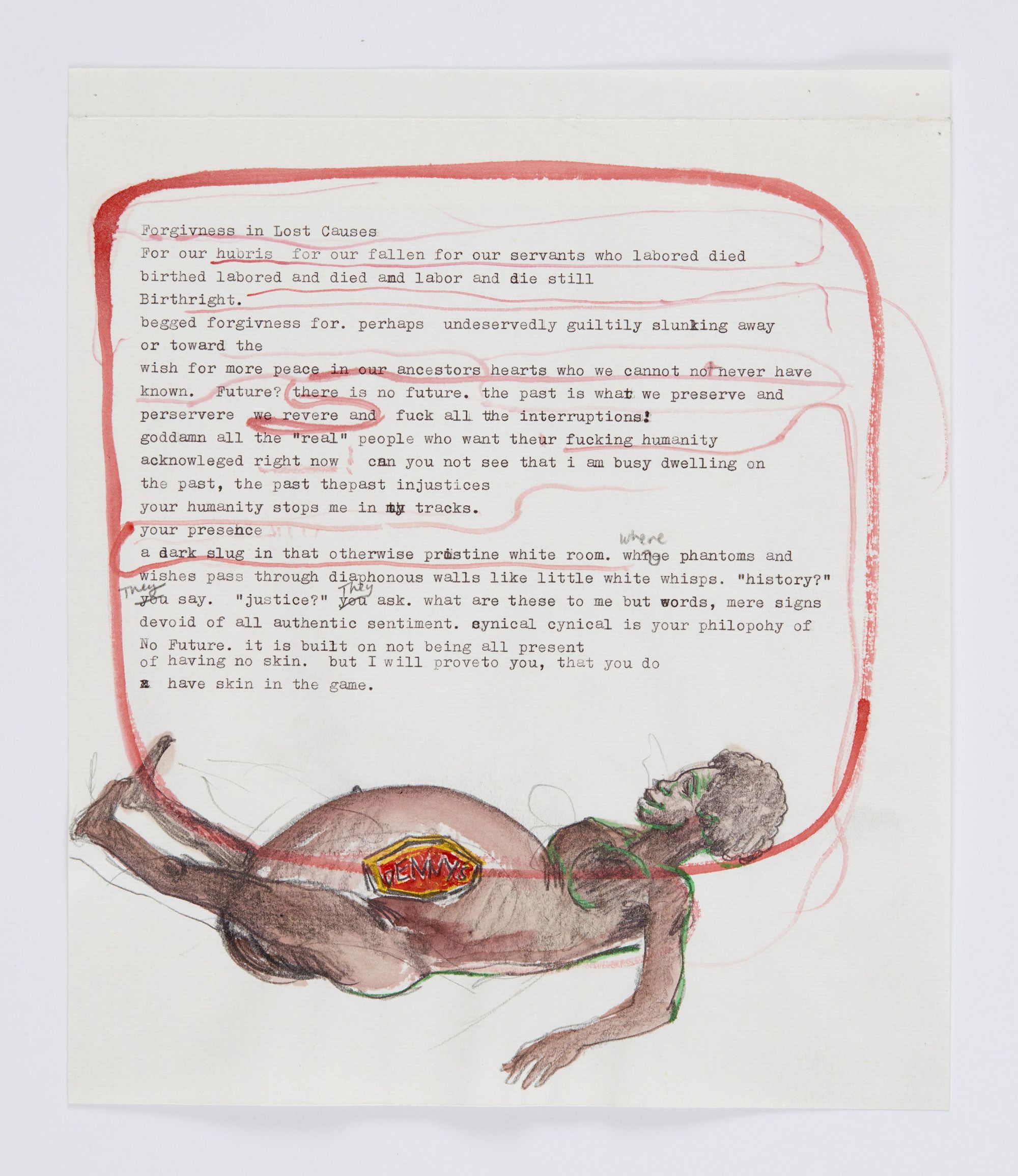
I walked around the show and thought: oh, this show is a gesture at words as images and then I asked myself if I’d been engaging with or overlooking her practice in that I saw her as everything I needed her to be for me: a black hole, a monolith. Then I stumbled across the following, where she minces, "NEXT. / THIS PROBLEM OF PRIORITIZING OF WORDS / OVER IMAGES. ESPECIALLY SINCE / YOU CAN DRAW FIGURATIVELY / —AND LITERALLY." Walker has cascaded the art world and general worldscape with information since her New York debut of An Historical Romance of a Civil War as It Occurred b'tween the Dusky Thighs of One Young Negress and Her Heart (1994), which opened at the Drawing Center in a group show. Walker’s work has been deemed grotesque, pornographic, violent—but really, it’s veracious. She takes words and turns them into sculpture, makes people out of voids, and sometimes empties out a page by carving out a person.
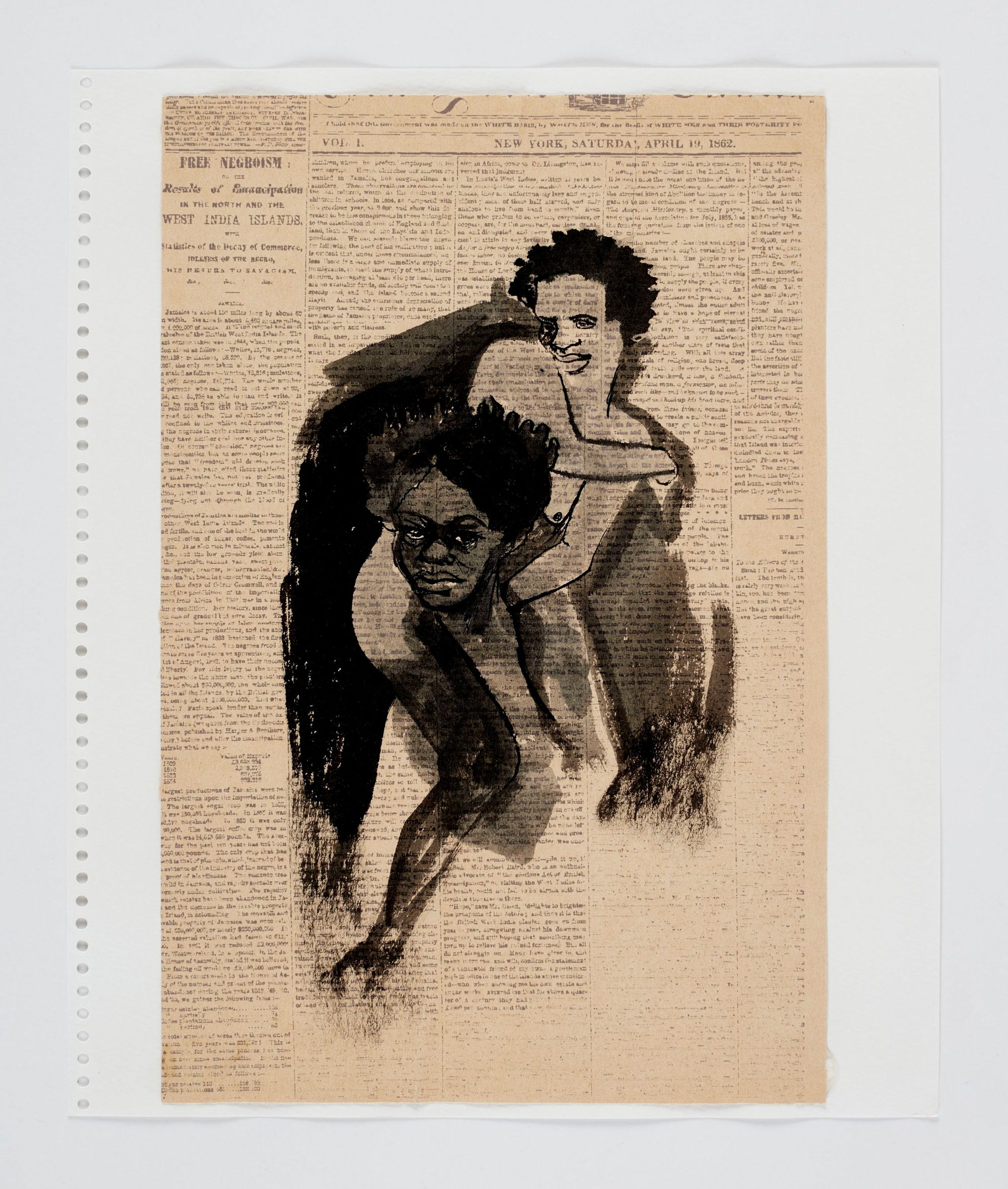
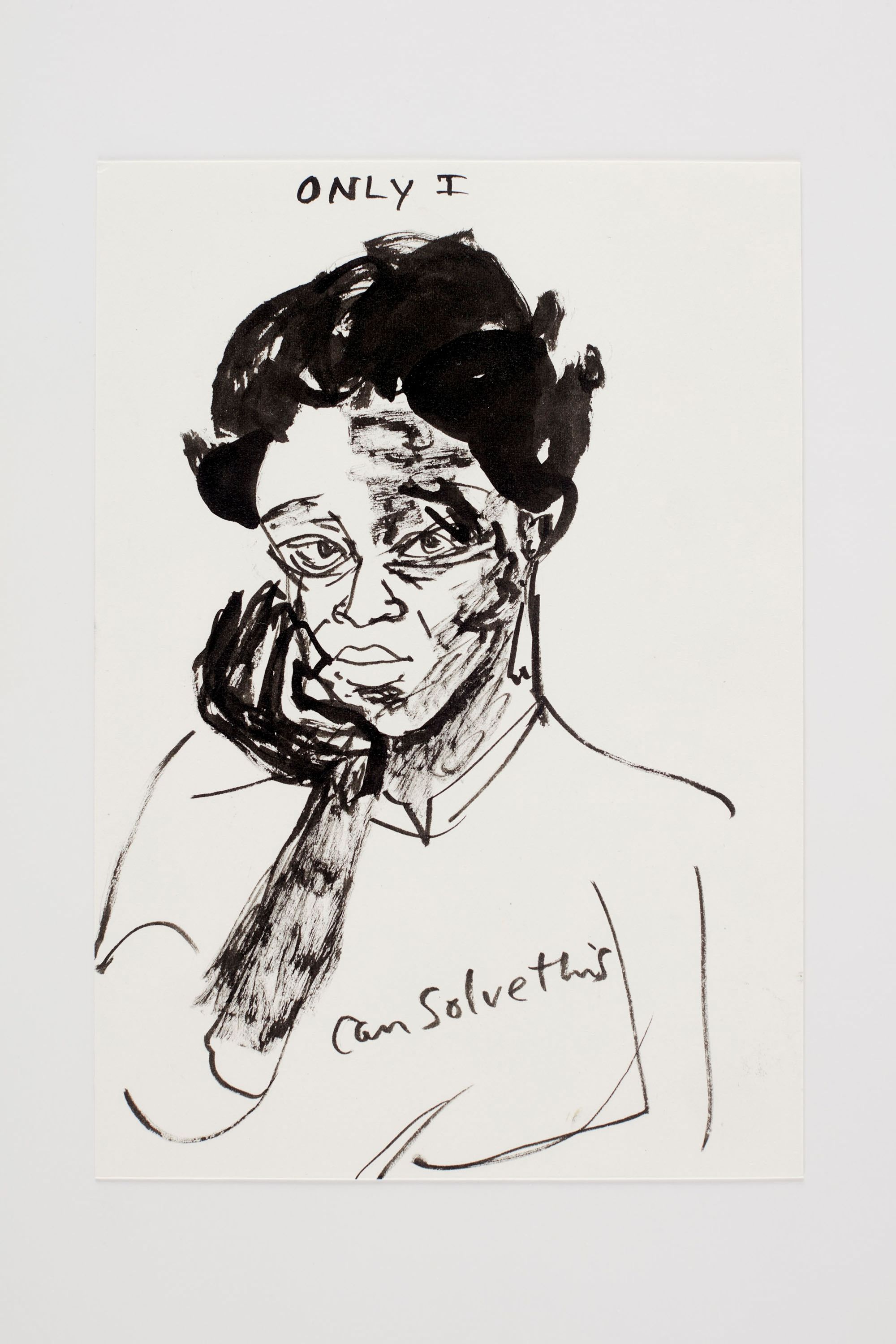
In 1997, three black people were awarded MacArthur Genius Grants. Alongside Kerry James Marshall and Brackette E. Williams, Walker was the third. Her work has consistently been compared to Francisco Goya’s "Black Paintings," simply on the occasion that they’re titled Black and imitate meager decapitation of a head and staged semblances of violence—or as some will simply say, they depict a mastery of sorts. Walker’s work is rarely engaged on a conceptual level because as she seems to bear it all, the void which is blackness doesn’t seem vast enough, to some, because the fictive characters often seem to close in on themselves as a world circling the drain. They are never challenged or entertained as a practice of one opening one’s self up or spilling and spreading the possibilities of a new world—one we’re faced with, which has become known as the past and the other more fictive than true, which we regard as the future (there’s no such thing as the present).
As John C. Bowels notes in "Adrian Piper: Race, Gender, Embodiment," in Contingent and Universal, Adrian Piper and The Minimalist Ideal, he leads with Piper recounting her experience of forgetting the social realities of life in New York: "I was drunk on intellectual construction, theory, abstract sculpture; swooping and serving crazily through uncharted sky. From that distance, all three-dimensional objects, found or constructed, sentient or inanimate, myself or others, were noumena: enigmatic entities assigned meaning by the encompassing conceptual framkework within which they are embedded." Piper knows the register of a presence and the lack of one, but the presence she is referring to isn't one that is didatic necessarily but she is living with and through the embodied, not working to present the present but to showcase a multitude of truths. Bowels continues, "People risked becoming neutral "noumena," Immanuel Kant's term for objects and ideas that have no physical properties. This is a fundamental principle of Kant's categorical imperative: that the meanings and relationships of objects and ideas are predetermined and fixed; they are neither perceived nor historical contingent but are known objectively and a priori. [...] In Minimalism, the object and viewer negotiate an experience of time and space; they share a situation defined only by such formalized elements as those Robert Morris enumerated in 1966: "object, light, space, body." The problem some artists began to recognize by the late 1960s was that Minimalism treated "body" as just one more expressionless material to manipulate, as if it existed, as Hal Foster argues, "before or outside history, language, sexuality, and power."
This idea of using the body as material reminds me of Bruce Nauman's Walking in an Exaggerated Manner Around the Perimeter of a Square (1967), which features Nauman wearing all Black, standing in the middle of a strip of tape, in the upright position, head forward and he moves his feet side-to-side while outlining the perimeter of an empty square. In the video, he repeatedly extends his left foot to the left end of the tape and then brings it back to center before extending his right foot to imitate the same motion. Nauman deliberantly shows the viewer how one can walk the perimeter of an outlined box. If you let your mind wander while staring at the screen–Nauman soon disappears and all you witness is the movement of a body, one that's devoid of meaning, draped in all Black, that doesn't lack in its intention or effort to move as someone bodied. We see him performing being embodied but should we believe him? What does he really mean through this gesture?
Away with the respectability politics within Black art and the universes of thought that are only already interested in engaging with or grasping for the legibility of an existence but fail to register the absence of one–or maybe even its traces, a fictive mapping of selves meeting a self. Walker's work takes to task the incisive term noumena in that her work features women with flat chests and penises, men sometimes with breasts and vaginas, which is to say that maybe the work hasn't ever lacked in what conveys but has failed to be recognized for what and as it is.
In 1998, months after winning the MacArthur Genius Grant, in a Bomb Magazine interview, Kerry James Marshall notes where he learned the fundamentals of how to draw. He incites, "And I used to watch this television program, John Nagy's Learn to Draw, which was also highly influential in my development. Nagy was so interested in more than just superficial forms of representation. He started with fundamentals, with the notion that everything you see is made up of three basic components: circles, squares, and triangles; and once you learn to break things down and then put those shapes in perspective, you can draw anything."
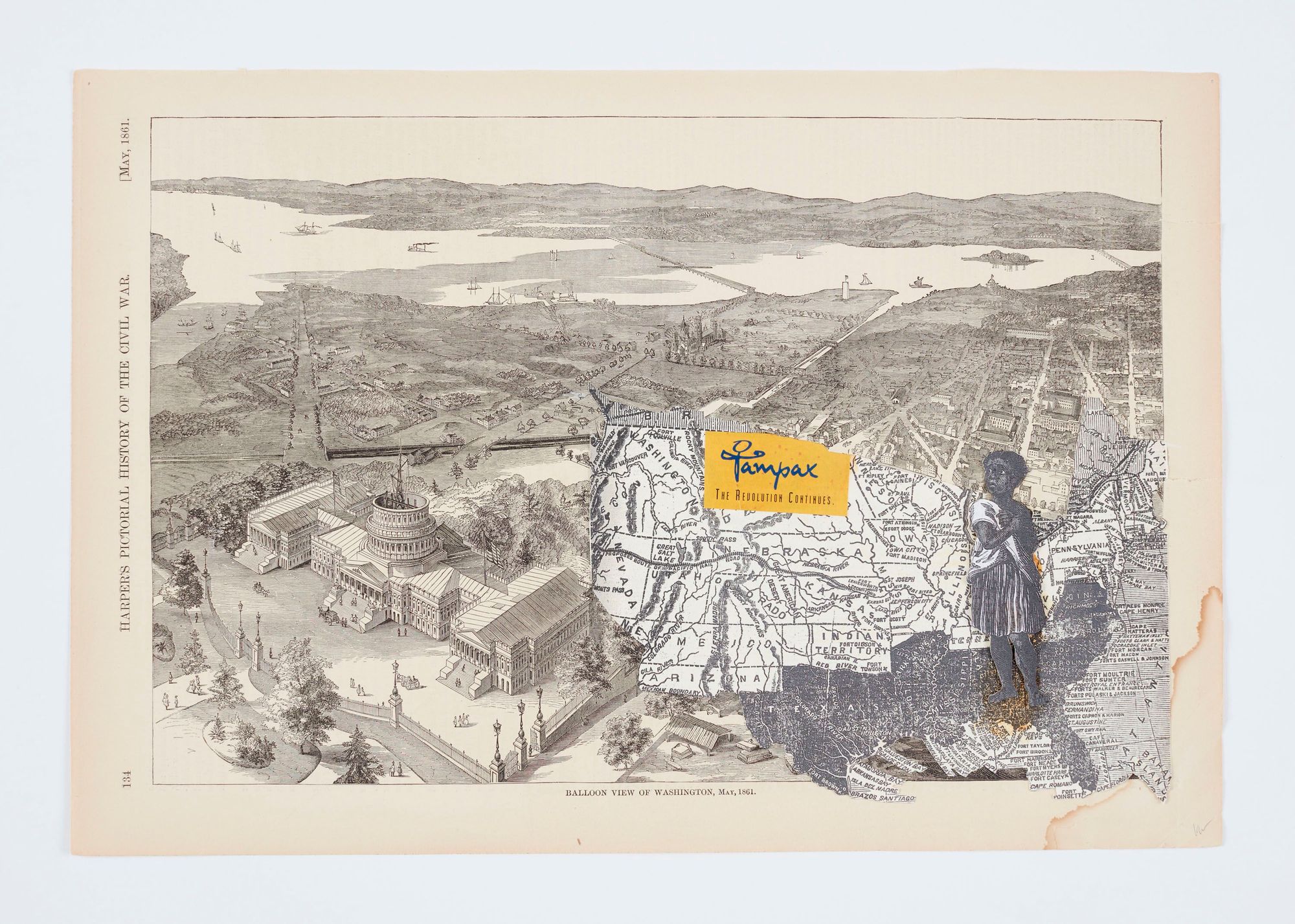
The Lingua Franca from Kara Walker's "Drawings" is on view until Semptember 30th, 2020.
- “Wretched Afrocentrism”
- “Every fuck wrote itself into existence”
- “Just belief a profoundly dangerous absence of doubt”
- “Resilience is wanting”
- “Wish: another good review / Result: mystified stares from noncomprehending public / Desire: a better body of work to follow”
- “Exposure. Dying from / See: mass murder, genocide, lynching–tied to a tree / See: striptease, pole dancer / or: internally displaced persons”
- “Trying to find a reason to work figuratively”
- “We knew ourselves before the end of race–safe suit”
- “The Inquisition–The Crusade–The Crucible”
- “Do you perpetuate justice by denying our right to spectacle? Choosing words over bodies / when it is bodies who want to be seen”
- “Freedom is a quick buck / Nature is a quick buck / God is a quick buck / History is a dead buck / My Atlanta”
- “Artwork you will love me for making in 50 years. 50 years from now.”
- “Placid on the Outside / Pernicious on the Inside”
- “…less likely with every passing second to ease myself into a new project / a new manner / a New MODE / perhaps I relish melancholy to what avail?”
- “Always attempting to fill these huge blank moments with an external form of love / becomes so impossible”
- “I was born a Man / and became a woman quite by accident. When I realized I had the biology for it / this is not I”
- “No pictures complete the loss / the absence I feel in my heart at not having you malign and injure me / no bad seed lives here now the ground is fallow / Dry
- “Black lives stopped mattering the moment he left office / darkness prevailed swallowing us / we merge / frightless / making the nightly news less / performance of race is minstrel show jump spin do-jest-so / Jim Crow dandy fair well fare well”
- “I meant to tell you I love you before I left you but / However, I said it so many times Before no matter / times changed / alligiences shift new policies emerge you were never who I thought you were but I needed to think it / to be more of what I could be / I needed your desire for me to be bigger / then your biggest dream”
- “Men want women to be there there–somewhere without our calm and compassionate vigilance it all goes to seed / Men want women to be silent guillible and witless / sexual up to a point and innocent up to another point the spectrum of what men want is short wavelengths of visible light”
- “Infrared beams convey your meanness words fail me”
- “WHEN ARE YOU GONNA GET OVER THAT? WHEN WHEN WHEN?”
- “Expert read of the post-post racial transition grace period minus police shootings of absent toward little black girls in bikinis / I survive / I survive”
- “QUEEN or KING Walker? Complain less! Make more art! / Give away art supplies narrow / your focus apply lubricant”
- “submission / don’t move under him / he will not notice you might be dead or pass out but not troube / not a “woman” who knows what she wants”
- “I was actually astonished to learn that in Berlin, a town plagued by racist attacks, hate crimes and neo-natzi activity–Blacks are not easy targets. / “Foreigners” Albanians, Turks / People from the east / looking for valuable jobs. / Blacks, I am told represent a specific privilege. / Rich enough to study, travel, provide profession beyond skilled labor… / are primary left alone. / Somehow I feel cheated my birthright”
- “The darkest shade of white”
- “WHO WILL WIN THE ONCE AND FUTURE RACE-WAR? / AND WHEN WILL IT BE OVER? / AND WILL THERE BE VETERAN’S BENEFITS?”
- “I seed there an image of my strong lean white masculine muscular tanned, self, perfection of a male species / I seed there a tenatious hilarious worker, a strength drawing critter able to pull whole worlds out of he emptiness of his being / That I loved / The imaginative boy / Playing the role of the master planner, acting like a MAN / Not wholly sure if being a woman wasn’t preferable / never able to decide on a name, or a tattoo. Never able to wholly be in love / withought draconian conditions put uponthe other don’t look me in the eyes sado_Masoch / In there I saw the Black (W)hole. My black (W)hole. / my familiar. Withcraft voodoo practioner. Don’t get on my bad side. I am the light. / the warm soft flow that lures sailors and moths to paradise or doom however you see it. / You who is attuned to darkness / only see darkness. light is hinted at, giving shape to / your black surfaces. / you look at me and see black surface, see historys slavery and darkly / scoff that your people have had it worse.”
- Mankind. / When will you ever listen? Kind of doesn’t matter, never matters. / Im counting on you to forget, even, that we had this conversation / where you told me, point black, held me to your absolute position / that there was no future, no future between us. that My future was my own / and so, although it took me months (12) to realize what you said was true as true as wh t your body did to spite your mouth. your words / still bit into Teflon black skin is less sensitive than white, thicker. / more able to put up with abuse. / denser even and here, am I, unknowing to myself, even, quietly resisting / your dumbass declaration. Believing the parts I want to believe. / delusional. / deliriously phantasmagorically in Love with the Love you offered me. / pure reflection of myself. you held me up a mirror and I loved what I seed there.”
- repitition / not a great beauty (of he south or anywhere) / no one ever tells Atlanta she is beautiful, just busy. gettin busy in the / dirty south. How does that leave Atlanta feeling? Love for her work / ethic and sense of style? never complimented for originality or / grace. neither a lumbering workhorse”
- SHE SMIRKS OUTLOUD your peaceful protest. She openly shirks / her ordained duty, as a blackwoman, as progenitor, as keepr of flame of bearer / of light, of model citizen of holder of higher standard. moral order. Nurse / WHETNURSE TO AN UNRULY REPUBLIC. / Henry Miller’s Nurse Shark. Blackwoman toothy grinned shirker of all / duty not her own. I mind my own, don’t care who gethurt. / Mothers motherfucker. / she remains silent on the issue. Children carry out for justice, refugees seek / asylum. Fathers play for approval, husbands all. / eyes avert, gazelanz abstractedly at apoint in the middle distance, soft focus / lips zip shut. body slackens, imperceptibly. seeming meek, dumb. But its a / a calculated turn away from your hunger, your need. to make anything out of her she dont need to be.”
- “DESCRIPTION / ATROCITY / Retelling / *yawn* / WARNING / WARNING / REPEAT”
- “its clear that at first we felt wrong, perhaps immoral, but we prayed / and there a was a voice, that answered back– and saw that it was good, / because it felt too good too good to pass on. and the pisser was, it is / how history gets made, your secrecy, the silence on thematter the silence / it was the silence your silence on he matter, though, your silence, / your silence, your reticen ce your down low, resistance to ever be known / to “it” ever being stated, the great injustice, workedits magic, to see, to witness but never name, to never say, makes all reality dissipate. a dream / a “is this happening?” is this now? are what we thik we are we are? / ? the, arewhat we think we are we are? is what I think this is, is?
- “But by then it will not / Matter if She lives or dies”
- “they he devout good women of the cause. caught up in his mysteries. / they keep the fires burning on the home front (don’t write him back) / they make the fight worth fighting. they BELIVE more than he, who hates / his father and becomes him. / they bolster and adore the way he destroys whole cities of himself. she is / killer thug in modest mother disguise. I am she and a notch bolder / no weapons at my disposal. Just belief profoundly dangerous absence of / doubt. sometimes the presence of another feeling a blank space / where fear or doubt might rest a dark slug in an otherwise pristine / white space. that is me. that is it, that was us. Slug LifeMatters. / activists, make life too easy. .palatable the unassailable / the mixed up and raging. raging bloodthirsty. animal. Instinctual. / Ifwe had weapons and a desirefor discomfort we could take out the monuments, / by force, not such wan actions. Removing the Jefferson Davis monument, for / instance, to go where? destroy it! take it out of hiding treat it to the bold unafraid treatment of blacksin the South and in America – have it bound / and arrested enmeshed in a network of go to Jail. Do not pass go. / United Daught of the Confederacy / so polite demure decorum so full of domesticiated sh t such a panty-waist / such a foul stink assed / “lady” / still dwelling on what scarlett did wrong and how she could make right / for none but herself I believe no one but herself. / HOMME FATALE / STONEY Mountain”
- “But I am Not a Racist! / I am only a Painting about / racist longing. a desire / for enmity stronger than the / Will to Survive. Painting like / me Honor our OWN LAWS / and logic and are freer than / you ever will be.”
- “This Painting does not / exist As Real Speech / as lynching does not / exist as Real Justice”
- “ART WHICH / is only visible / to BLACK / PEOPLE”
- “in that she is unable to activate the / jumble of letters she possesses. she must be / acted upon first. handled. conscripted. bound, / forced wide open . / so. my thesis, a black girl is made by / “white” society to be its / Antitheis / or let’s say, A black girl recognizes her / own willfulness, her power in reversing the / terms, she is possessed of this abject / sense of entitlement / she is “seductive” exotic, mysterious, illicit / and capable of tantallizing on that front. / she uses her mask like a dildo, inserting and retracting. her new counterpart, her choosing”
- “When it all fails, big plans domination-pute / kurtz and Brando and Ahab / and david Koresh and famous leader of old. / “KILL ALL THE NIGGERS” and that’s a quote. / Wherever NIGGERS might be found. (White Niggers, we’ve heard of , / Arab Niggers too. Where does a nigger begin and what exactly are you?”
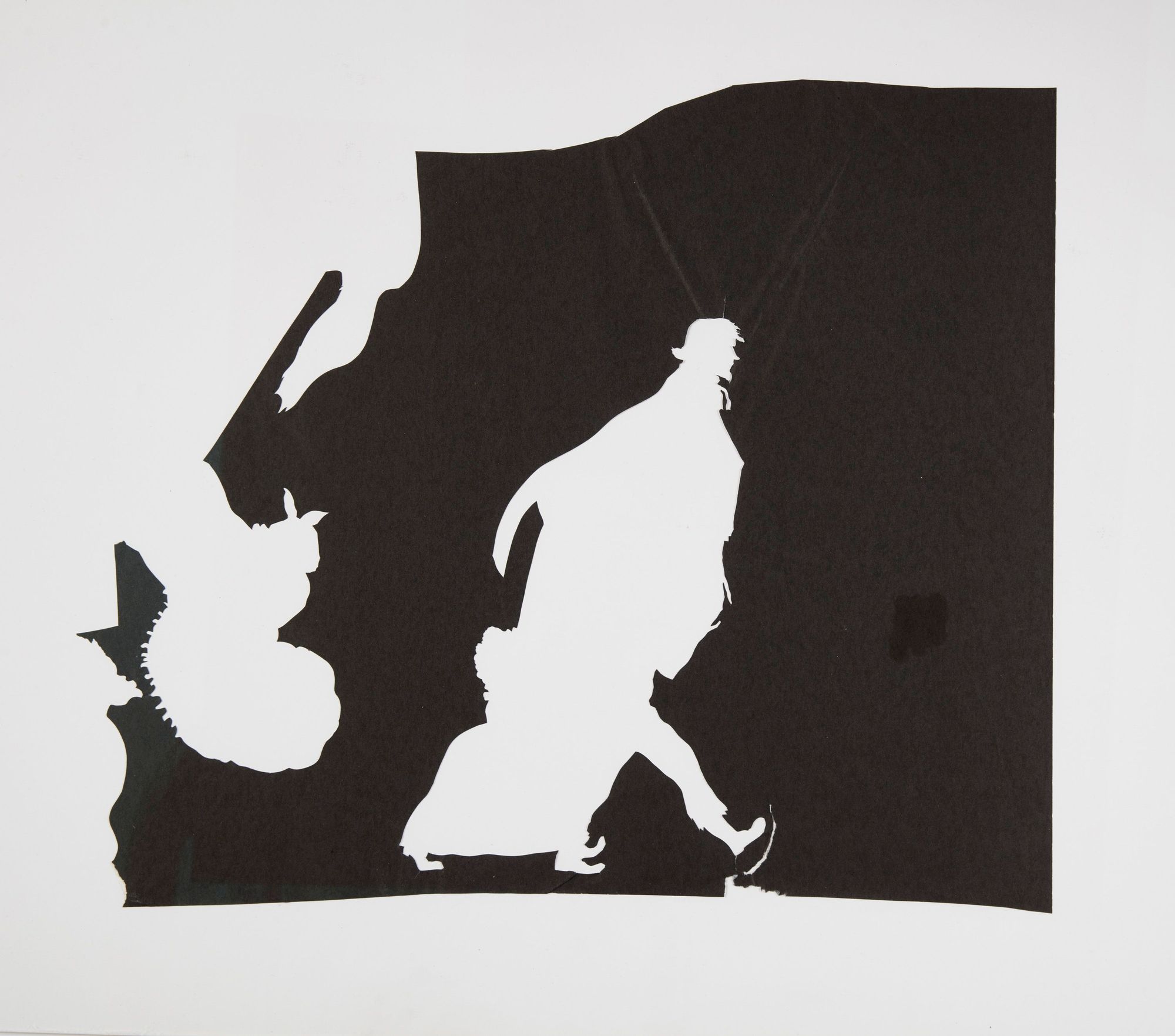

Subscribe to Broadcast